
Contact

Home
Hoaxes & Pranks: Monster Hunters
Securing a Bride.
The Brisbane Courier (Qld.)
Date: September 14, 1926
Page Number: 6
Primitive people generally go in for elaborate ceremonial at their marriages, feasts, and funerals. An exception, however, has been found, so far as the marriage ceremony is concerned, by Mr. F. A. Mitchell Hedges, the explorer While travelling in Guatemala, he visited the Zutuhile Indians, amongst whom he found the way to secure a bride to be the most curious he had discovered among the many native tribes he had lived with or hitherto visited. It is the custom of the women of the tribe to go to the lake side daily to fetch water, which they carry in large two-handled earthen pots balanced on their heads. If an Indian boy takes a fancy to a girl, he watches till she goes to the lake. He then hides himself by the stone boulders by the side of the path to await her return. When she arrives opposite the spot where he is hidden he rushes out, seizes the pot, and dashes it into fragments over her head. If she remains standing, a public betrothal is considered to have taken place. If she runs away, it signifies a refusal. This method of showing love seems both a violent and dangerous one. But the girls' skulls appear to be abnormally thick, for Mr. Mitchell-Hedges could not learn of a single instance where the girl had been stunned or her head cut open. He learnt, however, that the more fragments into which the pot was shattered the greater was supposed to be the love of the youth for the maid.
F. A. Mitchell-Hedges part 9



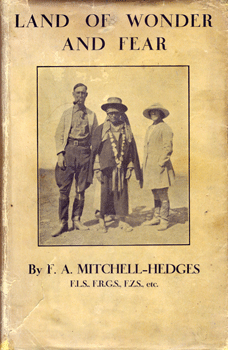
Frontispiece shows the author with the chief of the Zutuhile Indians SOURCE
Thompson wrote about Mitchell-Hedges
in Maya Archaeologist (1963), and his characterization was not flattering (p. 73):
He had penetrated the interior of British Honduras
to discover this immense mysterious city, which in fact, had been known to archaeologists and European residents since the last century
and had been described in print many years before. Worst of all from an archaeological point of view, he had workers build a wall
on one of the terraces to make a more impressive photograph. Later he and his collaborator [Lady Richmond Brown] wrote a book, Land
of Wonder and Fear; to me the wonder was how he could write such nonsense and fear of how much taller the next yarn would be.

NICARAGUA REVOLT
PEOPLE TAKEN BY SURPRISE
CONSCRIPTION IN STREETS
Barrier Miner (Broken Hill, NSW)
Date: September 30, 1926
Page Number: 1
(Special to "The Miner.")
London, September 28.
Mr. Mitchell Hedges, the explorer, in an article in the "Daily Mail" written from Nicaragua (Central America) vividly describes the revolution there against General Emiliano Chomorro (President).
It came like a bolt from the blue. Perfect peace and contentment prevailed one day and all the horrors of civil war the next. Men and boys were conscripted in the streets and sent into camp without an opportunity of saying farewell to parents and wives.
Mr. Hedges and others were actually calmly waiting at the British Legation, where they were to entertain the President, when they were startled by a report that he was likely to be assassinated on the way. However, General Chomorro arrived punctually. His car was filled with a personal guard followed by two motor loads of soldiers, while at least 20 guards with loaded guns and belts of cartridges stood a few feet from the table during the dinner. Every door was blocked by squads of soldiers.
After dinner when the President left the officers shouted orders and the soldiers closed round him in a solid body.




Emiliano Chamorro Vargas
U.S. Marines occupied Nicaragua from 1912 to 1933, except for a nine-month period beginning in 1925. From 1910 to 1926, the conservative party ruled Nicaragua. The Chamorro family, which had long dominated the party, effectively controlled the government during that period. In 1914, the Bryan-Chamorro Treaty was signed, giving the U.S. control over the proposed canal, as well as leases for potential canal defenses. Following the evacuation of U.S. Marines, another violent conflict between liberals and conservatives took place in 1926, known as the Constitutionalist War, which resulted in a coalition government and the return of U.S. Marines.

EXCITING SNAKE HUNT
BOA CONSTRTCTOR ESCAPES
FROM A RAILWAY VAN
Barrier Miner (Broken Hill, NSW)
Date: October 6, 1926
Page Number: 1
(Special to "The Miner.")
London, October 4.
A boa constrictor hunt at Paddington followed the return of Mr. Mitchell Hedges with a collection of Central American animals. A guard entering the railway van in which the collection was being carried from Plymouth, saw an 18ft. boa constrictor escape. He made a hurried exit and called Mr. Hedges. Volunteers entered the van and threw a coat over the head of the snake, which wriggled violently and hissed viciously at Mr. Hedges who, however, evaded its fangs.
With the aid of a newspaperman the snake was dragged to the platform and bundled into a cage containing two other reptiles.

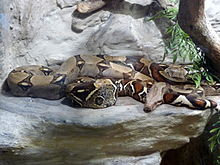



Tigers, but Not Rats!
The Register (Adelaide, SA)
Date: November 13, 1926
Page Number: 13
It is strange how the most courageous people have their peculiar little fears. Mr. Mitchell Hedges, the explorer, who returned this week from one of his expeditions to central America, told me that his colleague, Lady (Richmond) Brown, who has accompanied him on his adventurous journeys for several years, has not the least fear of any wild creatures. With her rifle and spotlight she will go alone into the jungle at night in search of a lion or tiger. She has taken part in battles with giant sharks, and has narrowly missed capture by by alligator. She has befriended all kinds of weird creatures, from a wild cat to a turtle, never suspecting that they might turn on her. But she has one great fear. When I talked to her in her suite at the Savoy Hotel she confessed that if a rat entered the room she would be 'petrified.'

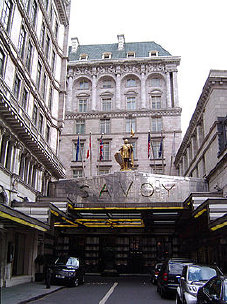

HER GREATEST THRILL.
Struggle With Giant Shark.
Western Mail (Perth, WA)
Date: November 18, 1926
Page Number: 25
A thrilling encounter with a tiger shark is described by Lady Richmond Brown and Mr. F. Mitchell Hedges, the well-known explorers, who arrived at Plymouth (Eng.) recently from Central America, having travelled 18,000 miles since February and bringing with them for the London Zoo three boa constrictors, which were lassooed by Indians in the interior of Venezuela (reports the London "Daily News").
Relating the adventure with the shark, which occurred in thc Caribbean Sea, Lady Richmond Brown admitted that it was the most thrilling moment of her life.
They were out fishing in a dinghy, when a shark of gigantic size was seen in the clear water of the lagoon with another in close attendance. The dinghy was manoeuvred to approach the tiger shark, the larger of the pair, and a big harpoon was launched, burying itself in the flesh behind the fins.
Then came a great struggle. The fish, which measured 19ft. 6in. in length, with 10ft. 4in. girth, put up a mighty fight. At high speed it travelled through the water of the lagoon, towing the dinghy. When it dived lengths of line had to be released to prevent the boat being pulled under water. An hour and a half passed without the shark's strength waning. Then suddenly it turned on its course and its swerve upset the dinghy.
"To talk of it now,"' said Lady Richmond Brown, "makes me think how I nearly became a luncheon for a tiger shark. It was two hours after we were picked up that the shark was killed in 5ft. of water."

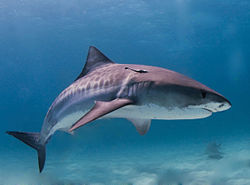

FISH FALL FROM SKY
MYSTERIES OF CENTRAL AMERICA
The Canberra Times (ACT)
Date: December 2, 1926
Page Number: 15
Mr. F. A. Mitchell Hedges the explorer who recently finished a tour of the Central American Republics writes of some of his experiences in these mysterious countries.
The Republic of Honduras is in many ways remarkable. There are thousands of square miles of jungle swamp and mountain where no white man has ever set foot. There are primitve Indian tribes whose culture has not yet reached that of the Stone and Iron Ages.
Their tribal customs and grotesque religious ceremonies are only vaguely suspected from the tales which reach outlying villages through other indian tribes.
In a remote part of this strange land a crimson stream gushes from the bowels of the earth. The Indians can not be induced to approach the place. They allege that millions of bats live in gigantic underground caverns and that the blood comes from their bodies as perpetually they fight and tear one another to pieces by thousands.
The Indians belive that at death all people who have lived an evil life on earth turn into bats. This is their conception of hell hence the place is regarded with dread. I suggest that this phenomenon is caused by a spring of water passing through mineralised red soil.
There are many mysteries in this country. In Yoro nearly every June dining the wet season swarms of fish, three to seven inches in length fall from the sky. The natives eagerly collect them, and they are considered a great delicacy. The Indians call this the feast of the fishes.
Leaving Tegucigalpa, the capital of the Republic of Honduras, on our 1000 miles journey to the Pacific, we passed through wonderful country before reaching San Lorenzo, where the Government launch awaited us. In this we crossed the Gulf of Fonseca which is much finer than the Bay of Naples, and arrived at the little town of Amapala, nestling at the foot of a big, extinct volcano, which rises out of the gulf and forms an island.
On the day of our departure a terrible chubasco (an electric storm preceded by violent wind) broke.
The placid waters of the gulf were turned into a seething maelstrom, and so great was the velocity of the wind that the water ripped from the waves into one's face like a whip.
It became black, as night. The storm redoubled in fury, several natives' dug-outs were blown up on the beach, and in the midst of this inferno there came a blinding glare. You could feel the heat and hear the rip of the flame, and the earth rocked under the shock of the explosion. The enveloping black pall was rent asunder and a roar of water fell in solid mass, flattening out the waves on the gulf. Five minutes later there was no sign of storm, and the sun blazed down from a clear sky.

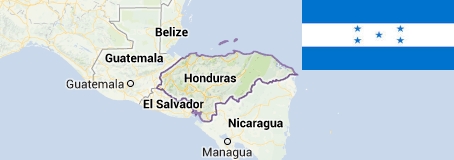

Lluvia de Peces (Rain of Fish) is a phenomenon that has allegedly been occurring for more than a century on a yearly basis in Yoro,Honduras.
The explanation generally offered for the rain of fish is meteorogical, in terms of strong winds or waterspouts, as
for other accounts of raining animals. The most likely source of the fish is the Atlantic Ocean, about 200km (140 miles) away. This
explanation is seen as improbable as it requires the unlikely coincidence of waterspouts collecting fish in the open sea every year
in May - June and transporting it directly to Yoro.
An alternative explanation is that the fish are fresh water fish, and that they
swim from a nearby river into a subterranean water current or cave system. The heavy rain washes the fish up out of their usual habitat
and the water recedes to leave the fish stranded.


Relics of a By-gone Race.
The West Australian (Perth, WA)
Date: December 10, 1926
Page Number: 15
An archaelogical site of great importance has been made known to the scientific world by the pioneer expeditions of Lady Richmond Brown, Mr. Mitchell Hedges, and Dr. Gann, a report of whose investigations carried out this spring has been presented to the Trustees of the British Museum. The discoveries were made at the ancient Maya site of Lubaantum, which is situated in the south of British Honduras, some 55 miles by river from the settlement of Punta Gorda. The site consists of a hill spur, rising rather abruptly, the summit of which has, in ancient times, been levelled, and upon it have been erected various edifices built of cut stone blocks, comprising pyramids and mounds enclosing courts which were certainly the scene of religious ceremonies. The sides of the hill spur have been carved to form a series of terraces, which have been faced with blocks of cut stone. Excavations at certain selected points proved that the masonry facing of manyof the mounds concealed an inner facing built in an other arehitectural style. It is clear from the report that the site of Labaantun was long occupied, and contains within its boundaries the history of architectural development and decline on the part of a primitive people, who had quarrred and dressed stone with stone tools.
...

HORRORS OF THE DEEP.
Whip Rays and Shy Crabs.
Western Mail (Perth, WA)
Date: December 30, 1926
Page Number: 27
"You may have the worst possible nightmare; conjure up in the imagination all that is hideous; think of all that is repulsive and loathsome so that you shiver at your very thoughts; and yet there are creatures living beneath the seven seas which are beyond the greatest stretch of the imagination."
So said Mr. Mitchell-Hedges, the explorer, during a recent broadcast talk in London on the horrors of the deep, and to assist the imagination of his listeners he related some of the weird experiences which befel him and Lady Richmond Brown during their two years' big-game fishing in Central America (reports the London "Daily Chronicle").
The largest fish he ever hooked was a hideous sawfish, weighing about 5,700 lb. He and Lady Brown were occupied five hours in killing and beaching it. Another fish, netted in the Caribbean, resembled a bird more than a fish.
"It proved to be a leopard—or whip ray-measuring," said Mr. Hedges, "from the tip of the nose to the end of the long, whip-like tail, 13¼ft., and eight feet across the wings. Its weight was 630lb. The tail itself was 8¼ft. long.
"Nature has provided the inside of the mouth with crashers, capable of such power and force that it can pick up that large mollusc, the conk, which weighs some pounds, and crush the shell, which it takes a man all his strength to break with a hammer.
"lt eats the pulpy substance within, and spits out the shell. The tail of this fish is armed with four long daggers, serrated and barbed at the edge like fish-hooks—a terrible weapon with which to be struck."
"We have obtained," he went on, "some extraordinary specimens. One is a crab, known as the 'Shy Crab.' Whenever it is approached, it covers its face completely with its large, flat claws, which fit so perfectly into the back-shell that it becomes indistinguishable from a round piece of coral rock.

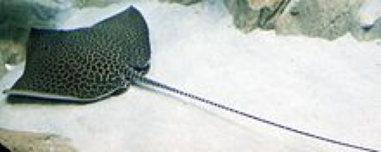

The leopard whipray (Himantura leoparda) is a little-known species of stingray in the family Dasyatidae, found in the Indian and Pacific Oceans from South Africa to Australia. It is found close to shore at depths shallower than 70 m (230 ft), over soft substrates. Attaining a width of 1.8 m (5.9 ft), this species has a diamond-shaped pectoral fin disc with a pointed snout and an extremely long, whip-like tail without fin folds.
A large species reaching 1.4 m (4.6 ft) across and 4.1 m (13 ft) long, the leopard whipray has a diamond-shaped pectoral fin disc wider than long and rather thick at the center, with narrowly rounded to angular outer corners. The very thin, whip-like tail measures 2.5–3.8 times as long as the disc.


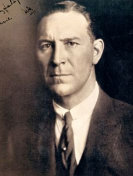
CONTENTS


































